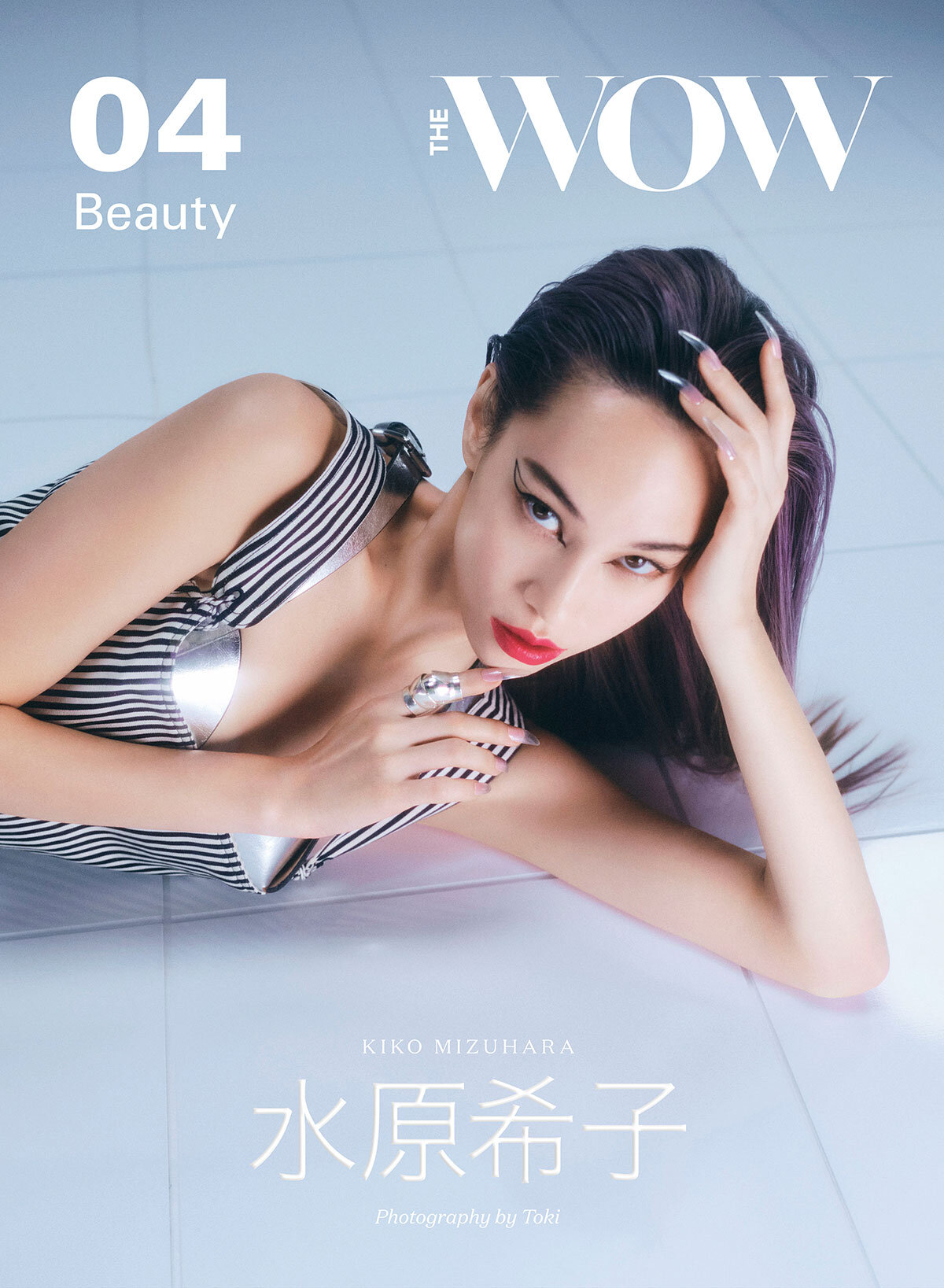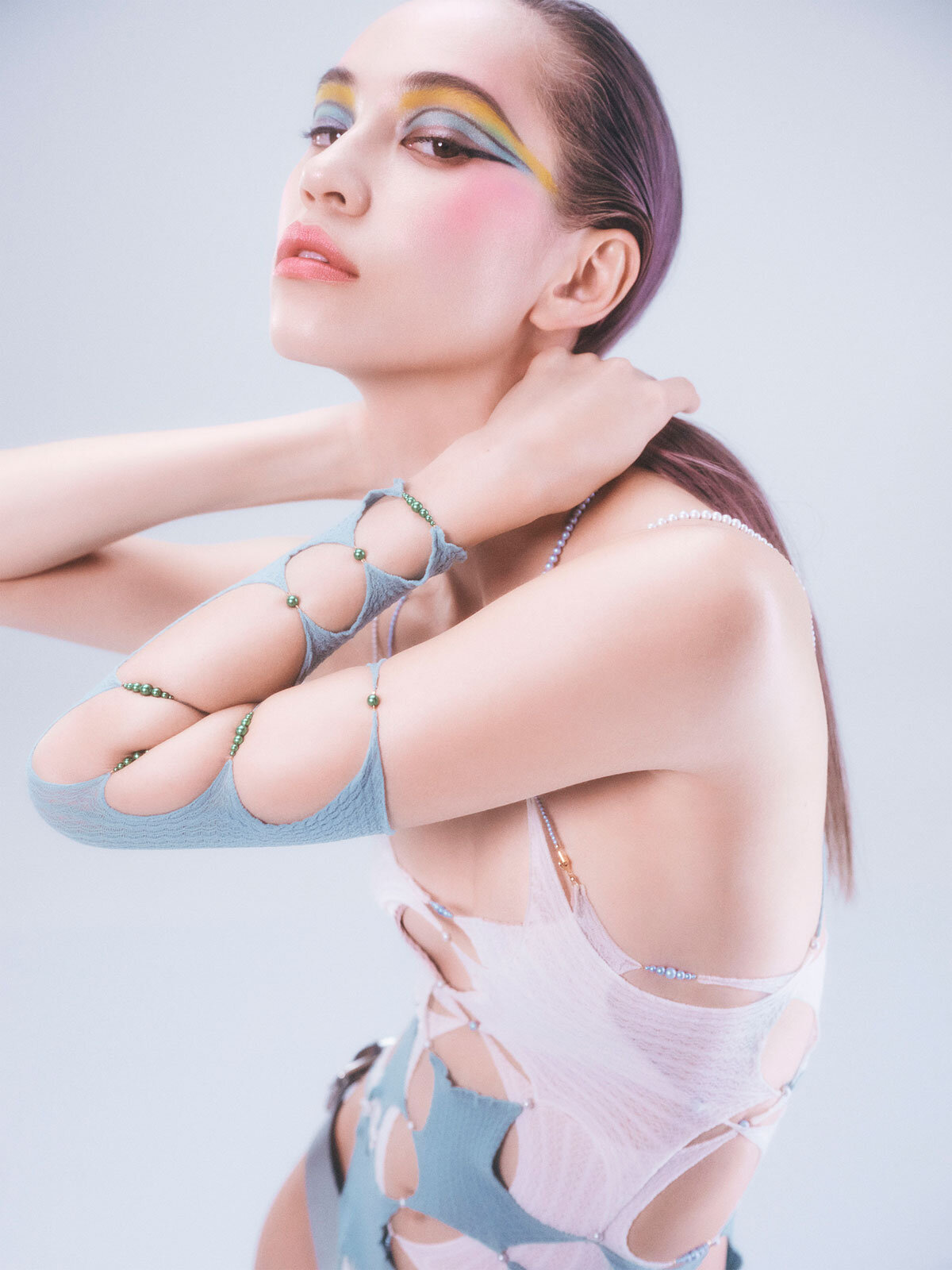KIKO MIZUHARA
One of Japan’s most famous supermodel rose to fame after starring in the adaptation of Haruki Murakamni's Norwegian Wood(2010), making her a household name. Now, she's pursuing her own creative projects.
bustier DIOR, bra FLEET ILYA, ring FANGOPHILIA
INTERVIEWER NAOMI MORRIS OMORI
PHOTOGRAPHER TOKI
ART DIRECTOR YUANN @ KIDZFRMNOWHERE
How do you ‘fit in' at a Japanese elementary school when your American surname, ‘Daniel’, is written on your name badge in katakana, a writing system used for foreign words, and your American and Korean ‘mixed roots’ immediately make you the odd one out? After growing up as a shy child, Kiko Mizuhara learned to navigate her multicultural identity as a teenager, and found that her uniqueness gave her strength. As an internationally successful model, actor, and designer, she is passionate about expressing and celebrating “originality and individuality,” which are, in her eyes, the true meanings of ‘beauty.’
After a career spanning over fifteen years, Mizuhara holds the status as a Japanese household name and global supermodel with 5.7 million Instagram followers on her profile – (@i_am_kiko) – Mizuhara is one of the top three most-followed Japanese celebrities on Instagram. Mizuhara has founded her own brand, Office Kiko (OK), and has increasingly turned to individual creative projects and independent collaborations alongside her high-profile modelling and acting work. For those outside Japan, you might also recognise Mizuhara for her 2017 Met Gala appearance, for being the first Asian person to become a Dior Beauty Ambassador, or for her appearance on Netflix’s Queer Eye Japan, starring as the Fab Five’s ‘tour guide’ in Tokyo.
dress YUEQI QI, bra and knickers FLEET ILYA , shoes DIDU
Today we are talking over a video conference call: I am ‘Phonecall from London’ on The WOW Magazine’s Art Director Anne Danao’s call-sheet, which makes me chuckle to myself because I sense it sounds more glamorous and mysterious than the reality. In the digital abyss that is my video conference waiting room, Mizuhara’s team joins my call. We bow and offer friendly introductions to each other, before they move the laptop camera around so that I am given a quick look around the photoshoot which they are about to wrap-up.
I witness a bustling scene in a studio in Aoyama, an area in Tokyo known for its high-end fashion and boutiques. It’s December 2020, so everyone is wearing masks due to he pandemic – R rates in Tokyo are considerably lower than in London, so the vibrancy and liveliness of the studio is a bittersweet reminder of better days. The laptop is left to one side as I wait to gain access to Mizuhara’s make-up room, where I will be talking to her. Soon enough, ‘Phonecall from London’ is brought into the make-up room and we greet each other, making introductions and bowing politely. Mizuhara is taking off her make-up from the photoshoot that day and applying moisturiser, wearing a casual but cosy long-sleeved grey crop top. Introducing herself, Mizuhara laughs candidly and apologises for being in the middle of taking her make-up off. Her laughter breaks the ice.
“What does beauty mean to you?” I ask her to distil the meaning of beauty into one sentence. She considers the question carefully. “Kosei”, she replies, adding an equally considered translation in English – “originality and individuality.” With hindsight, I realise that this belief threads through our conversation, her work, and her life story.
headpiece, bra, top, skirt and shoes DIDU, fishnet stockings STYLIST'S OWN
‘Mixed roots’
As someone who also grew up with a mixed cultural background in Japan, like Mizuhara, we both share a background which can be described in Japanese as ‘miikusu ruutsu,’ meaning, ‘mixed roots’, a term popularised in part by Edward Sumoto’s projects and documentaries, ‘Mixed Roots Japan’. I had been wondering if Mizuhara’s cultural background had anything to do with the high value which she places on artistic freedom as an adult.
Mizuhara was born in 1990 in Texas, and as a baby her family moved to Kobe. Her parents divorced when she was eleven years old, and she lived in Kobe for the rest of her childhood. When asked about her ‘mixed roots,’ she tells me, “I grew up in Japan with American and Korean roots. Everyone around me was fully Japanese. My last name only became Mizuhara [水原] when my parents divorced, but until then my surname was Daniel. This meant my name was Daniel Kiko [ダニエル希子].” It was written in katakana [a writing system mainly used for foreign-language words and loan words, rather than traditional kanji, a writing system which adopts Chinese characters, typically used for Japanese names] which meant that already, on paper, it looked different from the others].
“Just by name, I stood out. This brought embarrassment to me and made me feel like I was different. Some people around me would ask what I eat at home, for example. I don’t think this was said with bad intentions but purely because they saw me as a child who was a bit different from the rest. With all of this, I was quite a shy child. I was a bit embarrassed of being me. This was because my roots were different from the children around me.”
bodysuit and arm piece RUI ZHOU
Although it was reported by Kyodo News that 1 in 29 babies born in Japan had at least one non-Japanese parent in 2014, it is still common for children with ‘mixed roots’ in Japan to feel like an outsider and experience bullying and micro-aggressions at school, even on a daily basis. This discrimination can, of course, continue into adulthood. Additionally, there is a lot of stigma towards Koreans living in Japan, leading to the minority group experiencing much prejudice and racism, experiences which Mizuhara is unfortunately familiar with.
Notably, in 2017 there was backlash against Mizuhara being cast in an advert for Japanese brewing company, Suntory. On social media there were hate comments, including racism against Koreans, insisting that she didn’t qualify as an ambassador for the brand, mentioning her mother’s ‘Zainichi’ Korean-Japanese background. Mizuhara issued a statement on Twitter in response, remarking, “The incident made me realise that there are so many people who understand me,” Korea Daily US reported. “I will live as I am with a stubborn heart so that the world can move closer to be [coming] a place where people can live as who they are, wherever they are at.”
headpiece UR KEN, knickers FLEET ILYA
Despite these challenges, throughout the years spent in the media’s spotlight, Mizuhara has always come across as cheerful and full of positive energy, so it was unusual to see her share a rare moment of vulnerability in a recent interview…
The full version of this cover story and interview was published in our print issue The WOW N° 4
With thanks to Arthur Reiji Morris, Waco Yokoyama, and Hanako Lowry.
NAOMI MORRIS OMORI is a half British, half Japanese writer and creative currently based in London. After spending her childhood growing up in Japan, she is curious to write about multicultural identities and the arts.
TALENT KIKO MIZUHARA
STYLIST MASAKO OGURA
HAIR & MAKEUP RIE SHIRAISHI
NAIL ARTIST EICHI MATSUNAGA
SET DESIGN AKIHIRO YAMAYA
CGI ARTIST GAEL DELHAYE
FLOWER ARTIST MOCHIZUKI KOTA
EXECUTIVE PRODUCER ANNE DANAO
LOCAL PRODUCER TORU HOSAKA @ IINO GRAPHIC IMAGES
RETOUCHE SAKURAKO UCHINO @ IINO GRAPHIC IMAGES
SPECIAL THANKS IINO MINAMI AOYAMA STUDIO, MIN YUAN & MIMI YE @ MGA








